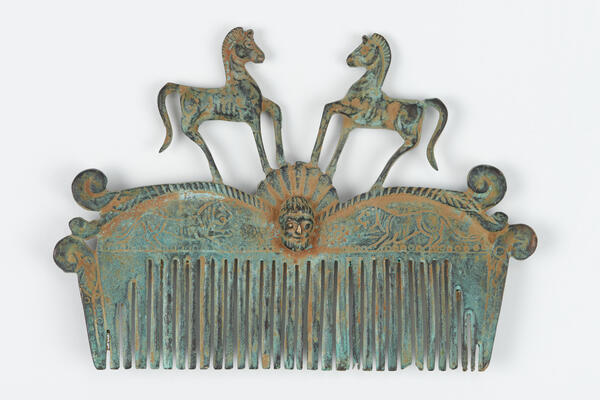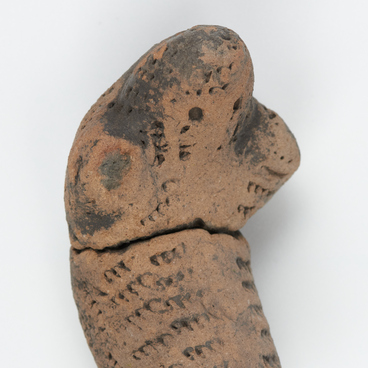The origin of the bronze comb from the Yershov Museum Complex of Ishim City collection is unknown. It looks like a Scythian golden comb from the Solokha burial mound of the 4th century BC, found by the archaeologist Nikolay Veselovsky in 1913 in Transnistria. Similar combs were found in other mounds of the 5–3 centuries BC. Therefore, researchers suggested that this exhibit could have been made during this period or later, up to the High Middle Ages.
Throughout history, bronze combs were used not only as a household item. They were used in religious rites — for example, people combed the fleece of a sacrificial ram. The teeth of the Ishim comb are not filed down and could damage the hair. Therefore, it may have been used during cult ceremonies.
After the Baptism of Rus, the tribes inhabiting these lands began to acknowledge Orthodox saints, but pagan beliefs did not disappear either. Since people could not put idols in huts or wear objects with shamanic symbols openly, they disguised pagan symbols as ordinary objects. Pagan pendants and shamanic plaques were transformed into combs that people could wear around the neck or at the waist. The comb was decorated with images of sacred animals, sacred symbols. For example, a horse in the Slavic tradition symbolizes goodness and happiness associated with the cult of the sun, which protects against diseases and troubles.
Scientists believe that the combination of disparate images on one product, popular at different times and in other parts of Eurasia, may indicate that the artisan was focused on a wide range of customers. It was impossible to determine the exact place of manufacture, but judging by the quality of the casting, it could be the workshops of Byzantium or Central Asia. This is also evidenced by the images of a lion and a lioness, which are not common for the decor on the territory of Ancient Rus. Researchers Viktor Zakh and Tatyana Rafikova pointed out that the item is not typical for the territory of Western Siberia, where it was allegedly found, either in terms of material or design of the finial. In Siberia, wooden and bone combs were more common.
Throughout history, bronze combs were used not only as a household item. They were used in religious rites — for example, people combed the fleece of a sacrificial ram. The teeth of the Ishim comb are not filed down and could damage the hair. Therefore, it may have been used during cult ceremonies.
After the Baptism of Rus, the tribes inhabiting these lands began to acknowledge Orthodox saints, but pagan beliefs did not disappear either. Since people could not put idols in huts or wear objects with shamanic symbols openly, they disguised pagan symbols as ordinary objects. Pagan pendants and shamanic plaques were transformed into combs that people could wear around the neck or at the waist. The comb was decorated with images of sacred animals, sacred symbols. For example, a horse in the Slavic tradition symbolizes goodness and happiness associated with the cult of the sun, which protects against diseases and troubles.
Scientists believe that the combination of disparate images on one product, popular at different times and in other parts of Eurasia, may indicate that the artisan was focused on a wide range of customers. It was impossible to determine the exact place of manufacture, but judging by the quality of the casting, it could be the workshops of Byzantium or Central Asia. This is also evidenced by the images of a lion and a lioness, which are not common for the decor on the territory of Ancient Rus. Researchers Viktor Zakh and Tatyana Rafikova pointed out that the item is not typical for the territory of Western Siberia, where it was allegedly found, either in terms of material or design of the finial. In Siberia, wooden and bone combs were more common.



